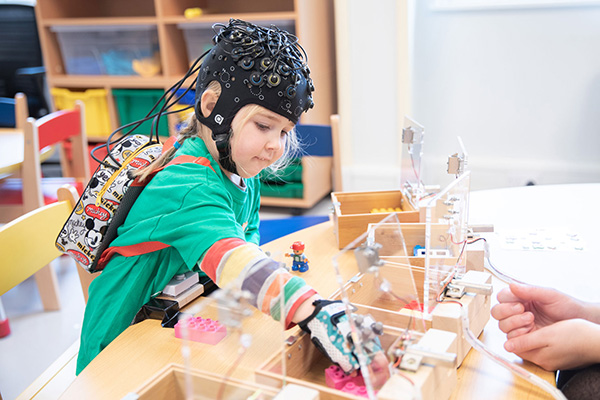This project is funded by the Leverhulme Trust.
Our team consists of Professor Denis Mareschal, Dr. Paola Pinti, Dr. Victoria Mousley and Becky Terry
If you or your child is interested in participating, sign up to our database
 Humans are a social species; we have evolved to work together to solve problems of mutual interest. Collaborative problem-solving is something that emerges in the first 5 years of life. This project explores how synchronization of brain and motor activity between two individuals emerges in preschool years, and whether it plays a role in improvement in collaborative problem-solving. Furthermore, we will develop novel analytic tools and child-friendly study protocol to explore behavioural and neural synchrony in freely-moving preschoolers.
Humans are a social species; we have evolved to work together to solve problems of mutual interest. Collaborative problem-solving is something that emerges in the first 5 years of life. This project explores how synchronization of brain and motor activity between two individuals emerges in preschool years, and whether it plays a role in improvement in collaborative problem-solving. Furthermore, we will develop novel analytic tools and child-friendly study protocol to explore behavioural and neural synchrony in freely-moving preschoolers.
The preschool years (3- to 5-year-olds) are a particularly important developmental period because they correspond to a phase of very rapid development in the planning, self-control, and multi-tasking skills necessary for complex problem solving in social contexts. It is also a period in which the child’s social environment is greatly expanded though going to school or participating in organised playgroups. However, it is also a particularly challenging age to study because preschool children find it difficult to sit still for the extensive periods of time required to acquire good quality neuorimaging data. Thus, the advent of lightweight and wearable neuroimaging technologies that can be fitted into a headcap (or "hat") provides a unique opportunity to shed some light on what has been described as the “black-hole" of developmental cognitive neuroscience research.
Little attention has been given to the contexts and situations that can promote shared goal formation during young preschoolers’ collaborative problem solving. So how might pre-schooler establish and maintain a joint goal—especially if they have poor overt communication skills? One possibility is social synchrony – including the synchronisation of brain activity and behaviours. Brain synchronisation between two individuals interacting socially has been observed in electrical brain activity (using Electroencephalography, EEG) and cerebral blood
oxygenation levels (using functional Near Infrared Spectroscopy, fNIRS) The mechanisms by which humans coordinate their brain responses in real-time during social interactions remain unclear. Hyperscanning involves recording brain activity in pairs of individuals engaged in a common activity. Using this technique, brain-to-brain synchrony in adults was found to be linked with behavioural synchrony and the degree of social connectedness
among partners. Several studies have also used neural synchronisation as a measure of the quality of the social bond and communication between a parent and child. Intriguingly, one study found that the interaction quality during a problem-solving task involving mothers and their preschool children determined the amount of neural synchrony observed in this couple; higher neural synchrony during cooperation predicted the pair's problem solving
success. This begs the question of whether similar markers correspond to better collaborative planning and problem solving in preschool peers.
With this in mind, our objectives are :
- To establish the casual role of neural synchrony in preschool collaborative problem solving; Does synchrony play a causal role in successful problem solving or is it just an incidental biproduct of both children coincidentally engaging in the same activity at the same time?
- To explore how factors, such as the familiarity of interacting peers or the task that the children are engaged in, mediate synchrony; Do the preschoolers synchronise more with friends and family? And is synchrony task dependent?
- To establish how this synchrony develops with age; Does the quality of synchrony improve with age and experience, and is this related to children’s improved ability to detect subtle cues in their partner's behaviour signalling a desire to collaborate?
- To develop analytic tools that will enable the analyses and integration of multiple streams of neural and behavioural information in this difficult to assess age group.
- To chart the development of neural and behavioural synchrony in natural environments involving multiple peers; Do our findings still hold when we take developmental cognitive neuroscience out of the lab and into the real world?
This project addresses questions that are fundamental to the understanding of human cognition and how it is shaped by the people we interact with. It also addresses the fundamentals of human development in exploring how we gradually become sensitive to cues that enable us to harness the collaboration of others. The Toddlerlab facility is a “world first” facility that enables us to move developmental cognitive neuroscience out of the lab and into the real-world. Wearable neuroimaging technologies will enable young children to move about
and interact freely and display natural behaviours. This will enable us to gather richer data recorded in more ecologically-valid contexts than laboratory environments. The project will also lead to technological and methodological innovations in developing data pipelines for combining the complex multimodal data collected simultaneously on multiple children. This will provide a solid methodological platform that can be used as the backbone for future studies of this kind. Finally, the findings will be of interest to a broad community of researchers (psychology, neuroscience philosophy, cognitive science, engineering) as well as parents everywhere.
If you or your child is interested in participating, sign up to our database, and we will invite you as soon as your child is in the right age group.
